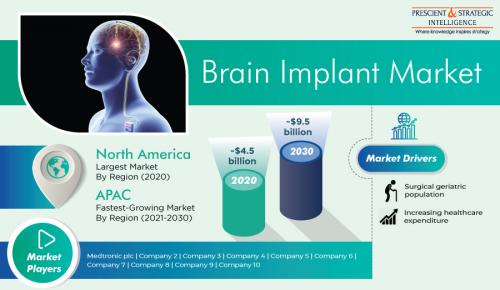Brain Implant Market To Boom in a World Plagued with Neurological Diseases

The global brain implant market revenue stood at $4.5 billion in 2020, and it is predicted to rise to $9.5 billion by 2030. According to the estimates of the market research company, P&S Intelligence, the market will exhibit rapid expansion during 2021–2030 (forecast period). The major factors fueling the growth of the market are the rising prevalence of neurological diseases, such as Parkinson’s, epilepsy, essential tremors, and Alzheimer’s, increasing healthcare expenditure, surging population of geriatric people, and growing incidence of depression across the world.
With the falling death rates and increasing life expectancy, the population of geriatric people is rising sharply all over the world. According to the World Population Ageing 2020 report published by the United Nations Department of Economic and Social Affairs (UNDESA), the population of people aged 65 years or above will rise from 727 million in 2020 to more than 1.5 billion by 2050. Moreover, the share of geriatric people in the global population is expected to surge from 9% in 2019 to around 16% by 2050.
Geriatric people need extensive care as they are highly vulnerable to neurological diseases and depression and thus, their growing population is fueling the demand for brain implants. The other major brain implant market driver is the rising public awareness about neurological diseases and their treatment procedures around the world. Owing to the measures taken by various private and public organizations, the public awareness of mental illnesses has surged sharply over the last few years. The World Health Organization (WHO) has declared October 10th as the World Mental Health Day to raise public awareness about various mental illnesses, provide mental healthcare services, and reduce the stigma associated with these diseases.
Make inquiry before purchase of this report: https://www.psmarketresearch.com/send-enquiry?enquiry-url=brain-implant-market-outlook
Similarly, the National Alliance on Mental Illness (NAMI), which is a mental health organization based in the U.S. and supports treatment, research, and campaigns aimed at raising public awareness about mental diseases, was founded in 1979 in order to improve the lives of those suffering from various mental health conditions. Depending on type, the brain implant market is divided into spinal cord simulation, vagus nerve stimulation, and deep brain stimulation. Out of these, the deep brain stimulation category is predicted to dominate the market in the coming years.
This is attributed to the various benefits of deep brain stimulation, such as reduction in slowness, walking difficulties, and stiffness, on account of neurological diseases, such as essential tremors and dystonia. Geographically, North America contributed the highest revenue to the brain implant market in the past. This was because of the surging geriatric population, rapid technological advancements and innovations, existence of several major players, and increasing number of product launches in the region. Additionally, the growing incidence of neurological diseases is also pushing up the demand for brain implants in the region.
Hence, it can be said without hesitation that the sales of brain implants will soar in the coming years, primarily because of the rising incidence of neurological diseases and ballooning population of geriatric people all over the world.
Advertise on APSense
This advertising space is available.
Post Your Ad Here
Post Your Ad Here
Comments